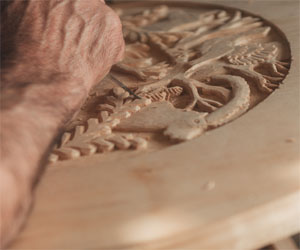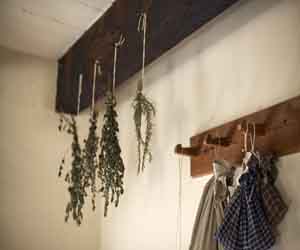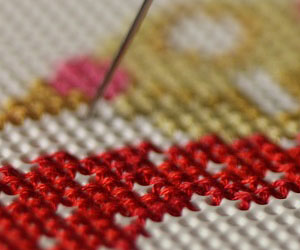


Crafting Beauty And Functionality

Wood, with its natural beauty, versatility, and timeless appeal, has been a medium for human creativity for centuries. The act of creating with wood, whether through woodworking, carving, or other techniques, allows individuals to express their artistic vision and produce objects that are both beautiful and functional. In this article, we explore the art of creating with wood and its enduring significance.
An Endless Canvas: Wood is a medium that beckons to be shaped, carved, and transformed. It offers an endless canvas for creativity, with its unique grains, textures, and colors. Every piece of wood has a story to tell, and artists who work with it bring those stories to life through their creations.
From Functional To Decorative: Creating with wood spans a broad spectrum, from crafting functional items such as furniture, cabinetry, and household objects, to carving intricate sculptures and decorative art pieces. This diversity allows artists to express their creativity across a wide range of styles and purposes.
Traditional Techniques And Modern Innovations: The art of creating with wood combines traditional techniques handed down through generations with contemporary innovations. Woodworkers may employ age-old joinery methods like dovetails and mortise and tenon, while also using modern power tools for efficiency. This harmonious blend of old and new techniques gives rise to a rich tapestry of creations.
The Joy Of Craftsmanship: Woodworking, in particular, is a craft that places great emphasis on craftsmanship. It demands precision, attention to detail, and an unwavering commitment to quality. Whether it's shaping a piece of wood with hand tools or operating sophisticated machinery, the satisfaction of creating something with one's own hands is immeasurable.
Functional Beauty: One of the most remarkable aspects of creating with wood is the fusion of beauty and functionality. Woodworking, for instance, produces items that serve practical purposes while also being aesthetically pleasing. Chairs are designed for comfort, tables for stability, and cabinets for storage, but each is also a piece of art that enhances living spaces.
Sculpting Emotions: Artistic creations with wood go beyond the functional. Wood carvers, for instance, transform raw timber into intricate sculptures that convey a wide range of emotions. From serene and serene figures to dynamic, abstract forms, wood allows artists to sculpt their feelings and experiences into tangible art.
Sustainable And Earth-Friendly: Working with wood is often synonymous with sustainability. Responsible sourcing of timber, coupled with the durability and recyclability of wooden items, makes it an eco-friendly choice. Artists and craftspeople who create with wood are increasingly adopting environmentally conscious practices, further enhancing the medium's appeal.
Legacy And Tradition: Creating with wood carries the weight of tradition and heritage. Many woodworking and carving techniques have been passed down through generations, preserving cultural legacies. The knowledge and skills of woodworkers and carvers ensure that these traditions remain vibrant and relevant.
Creating with wood is a testament to the enduring appeal of a medium that offers both artistic expression and functionality. Whether it's the creation of furniture that enhances our daily lives or the carving of sculptures that touch our souls, the art of working with wood continues to captivate and inspire. It bridges the gap between tradition and innovation, resulting in enduring creations that enrich our lives and leave a lasting legacy for future generations.
Herbs For Homemade Remedies
 Creating Your Herbal Toolkit
Creating Your Herbal Toolkit
To get started with herbs for homemade remedies, it's essential to build a basic herbal toolkit. Here are some key herbs to consider:
1. Lavender: Known for its soothing properties, lavender can help alleviate stress, anxiety, and insomnia. It's often used in teas, essential oils, and as a topical treatment for burns and insect bites.
2. Echinacea: Echinacea is celebrated for its immune-boosting capabilities. It's commonly used to fend off or reduce the duration of colds and flu.
3. Aloe Vera: Aloe vera is renowned for its ability to heal skin ailments, from sunburn to minor cuts and wounds. Its gel is a go-to remedy for soothing and repairing damaged skin.
4. Chamomile: Chamomile is a gentle herb used to calm digestive issues and promote relaxation. It's often found in teas, but its essential oil can be used topically for various skin conditions.
5. Peppermint: Peppermint is a versatile herb known for aiding digestion and alleviating headaches. It can be used in teas, infused oils, or as a topical rub.
6. Calendula: Calendula is prized for its skin-healing properties and is a primary ingredient in salves, creams, and ointments for skin irritations and rashes.


From Earth To Artistry
 The History Of Clay Sculptures: The origins of clay sculptures can be traced back to prehistoric times when early humans fashioned clay into small figurines and objects. These early creations were often utilitarian, serving as fertility symbols or talismans. As civilizations advanced, clay sculptures gained more prominence, taking on religious, decorative, and artistic significance.
The History Of Clay Sculptures: The origins of clay sculptures can be traced back to prehistoric times when early humans fashioned clay into small figurines and objects. These early creations were often utilitarian, serving as fertility symbols or talismans. As civilizations advanced, clay sculptures gained more prominence, taking on religious, decorative, and artistic significance.
In ancient Greece, for example, clay was employed to create intricate figurines, pottery, and votive offerings. The renowned terracotta warriors of China's Qin Dynasty, dating back over 2,000 years, are an exceptional example of the artistry and craftsmanship that can be achieved through clay sculpture. These life-sized, meticulously detailed soldiers were created to accompany the first Emperor of China in his afterlife, attesting to the importance of clay sculptures in historical contexts.
The Techniques Of Clay Sculpting: Clay sculpting encompasses various techniques, with artists employing handbuilding, coiling, slab-building, and wheel-throwing methods. Handbuilding involves directly manipulating the clay by pinching, coiling, and smoothing to create the desired shape. Coiling uses rolled clay ropes to build forms, while slab-building cuts flat pieces of clay to construct sculptures. The potter's wheel is yet another approach, allowing for precision and symmetry in shaping clay.
The Firing Process: One of the defining aspects of clay sculptures is the firing process. After the artist shapes the piece, it is left to dry, followed by firing in a kiln. Kiln temperatures can vary, resulting in different finishes and properties of the sculpture.
The Fascinating World Of Ancient Brewing
 Brewing As A Cultural Ritual: In ancient societies, brewing held a special place in both religious and social contexts. Beer was often associated with various deities and played a vital role in religious rituals. In Egypt, for instance, beer was a part of offerings to the gods, while in Sumeria, it was seen as a gift from the goddess Ninkasi, who was not only the goddess of beer but also a symbol of the Sumerian way of life.
Brewing As A Cultural Ritual: In ancient societies, brewing held a special place in both religious and social contexts. Beer was often associated with various deities and played a vital role in religious rituals. In Egypt, for instance, beer was a part of offerings to the gods, while in Sumeria, it was seen as a gift from the goddess Ninkasi, who was not only the goddess of beer but also a symbol of the Sumerian way of life.
The Influence Of Ancient Brewing: The techniques developed by ancient civilizations have had a profound influence on brewing throughout history. The knowledge of fermenting grains, along with the discovery of hops in medieval Europe, led to the development of beer as we know it today. Ancient brewing traditions continue to inspire modern craft brewers who look to revive old recipes and ingredients to create unique and historically accurate brews.
Brewing In the Modern Age: Despite the vast differences between ancient brewing techniques and modern practices, there are some striking similarities. Both ancient and contemporary brewers share a fundamental understanding of the transformative power of yeast. Yeast, the microorganism responsible for fermentation, was a key component in ancient brewing and continues to be the cornerstone of brewing today.
Moreover, the reverence for beer as a social and cultural drink has endured through the ages. Just as in ancient times, beer today continues to bring people together, whether it's enjoying a pint at a local pub or brewing with friends in the comfort of one's home.
Nourishing Your Locks Naturally
 No Harmful Chemicals: Conventional haircare products often contain harsh chemicals that can strip hair of its natural oils and lead to damage and breakage. Organic haircare products are free from these potentially harmful chemicals, which means they're less likely to cause long-term damage to your hair.
No Harmful Chemicals: Conventional haircare products often contain harsh chemicals that can strip hair of its natural oils and lead to damage and breakage. Organic haircare products are free from these potentially harmful chemicals, which means they're less likely to cause long-term damage to your hair.
Environmentally Friendly: Organic haircare brands often prioritize sustainable and eco-friendly practices. They use ingredients sourced from ethical and sustainable suppliers and package their products in recyclable or biodegradable materials. This reduces the environmental impact of haircare routines.
Nourishing Ingredients: Organic haircare products often contain nourishing and hydrating ingredients like aloe vera, coconut oil, argan oil, shea butter, and essential oils. These natural components provide moisture, shine, and strength to your hair.
Safer For Color-Treated Hair: For those who color their hair, organic haircare products can be gentler and safer. They help maintain the vibrancy of hair color without the risk of fading or damage.
Holistic Hair Health: Organic haircare takes a holistic approach to hair health. It emphasizes the interconnectedness of overall well-being with healthy hair. A well-balanced diet, adequate hydration, and reduced stress are all factors that contribute to the well-being of your hair.
Gentler On Sensitive Scalps: Organic haircare products are formulated with milder, natural ingredients that are less likely to irritate sensitive scalps. They can help alleviate issues like dandruff, itchiness, and flakiness without causing further discomfort.
The Beauty Of Green Handmade Goods
 Artistic Innovation Meets Sustainability
Artistic Innovation Meets Sustainability
Green handmade goods are a testament to the union of creativity and environmental responsibility. Crafters and artisans across the globe are channeling their talents to produce items that not only serve a functional or decorative purpose but also adhere to eco-friendly principles. These goods are often made using natural or repurposed materials, creating a harmonious blend of artistry and sustainability.
Supporting Local Economies
One of the significant advantages of green handmade goods is their role in supporting local economies. Artisans and crafters, often small-scale businesses or individuals, contribute to their communities by crafting unique items. This helps strengthen local economies and reduces the carbon footprint associated with mass-produced, globally distributed products.
A Reduction In Waste
The process of creating green handmade goods encourages a reduction in waste. Many artisans rely on repurposed or upcycled materials, diverting items that might have otherwise ended up in landfills. The upcycling trend, in particular, is a testament to the innovative and sustainable approach taken by crafters.
Customization And Personalization
Green handmade goods offer a level of customization and personalization that is often lacking in mass-produced items. Artisans can tailor their creations to meet the unique needs and preferences of their customers. This not only reduces overconsumption but also fosters a deeper connection between the product and its owner.
The Artistry In Every Stitch
 Quilting: Quilting is a technique that marries practicality and artistry. Quilts are made by stitching layers of fabric together, often with intricate patterns. Traditional quilt designs tell stories and are passed down through generations. Quilting stitches can be simple or highly detailed, adding depth and warmth to these cherished heirlooms.
Quilting: Quilting is a technique that marries practicality and artistry. Quilts are made by stitching layers of fabric together, often with intricate patterns. Traditional quilt designs tell stories and are passed down through generations. Quilting stitches can be simple or highly detailed, adding depth and warmth to these cherished heirlooms.
Cross-Stitch: Cross-stitch is known for its precise, grid-based patterns created by "X" stitches. It is a popular choice for decorative items like samplers and personalized gifts. The process is meditative, requiring attention to detail and precision in every stitch.
Appliqué: Appliqué is the art of attaching smaller pieces of fabric onto a larger base to create images, patterns, or designs. This technique can be found in quilting, clothing, and decorative textiles. Appliqué often involves intricate stitching to secure the fabric pieces and add embellishments.
Thread Painting: Thread painting is a technique that mimics the strokes of a painter's brush with colored threads. Artists use varying thread densities and colors to create detailed images on fabric. The result is a stunning visual masterpiece.
Modern Innovation: Threadwork techniques have also embraced modern technology. Computerized embroidery machines allow for intricate and repetitive designs with precision and speed. Additionally, contemporary artists often combine traditional techniques with digital art, creating a fusion of the old and new.
Cultural Significance: Many threadwork techniques carry cultural and historical significance. The choice of colors, patterns, and motifs can reflect the heritage and storytelling of a particular community.